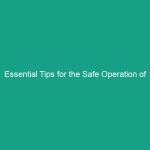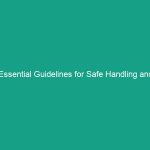Good morning team!
Today, we are going to discuss an important topic that affects all of us here at the workplace: Essential Guidelines for Safe Equipment Use: Avoid Critical Risks. Understanding these guidelines is crucial for maintaining a safe work Environment and ensuring that everyone goes home healthy at the end of the day. Safety is our top priority, and by following these guidelines, we can minimize risks and protect ourselves and our colleagues.
Understanding Essential Guidelines for Safe Equipment Use
When we talk about essential guidelines for safe equipment use, we refer to the set of practices and rules designed to ensure the safe Operation of machinery and tools in the workplace. This is important because improper use of equipment can lead to accidents, injuries, or even fatalities. It impacts our daily operations by affecting productivity, morale, and overall Workplace Safety.
One common misconception is that only certain types of equipment require strict Safety Guidelines. In reality, every piece of equipment, regardless of size or complexity, has its risks and requires safe handling Procedures. Remember, safety is everyone’s responsibility, and it’s crucial to approach every task with caution.
Key Hazards, Risks, and Safety Considerations
Every workplace has its unique set of Hazards, but there are some common risks associated with equipment use that we should all be aware of:
- Mechanical Hazards: Moving parts can cause serious injuries if not handled properly.
- Electrical Hazards: Equipment that uses electricity poses risks of shock or fire.
- Ergonomic Hazards: Improper lifting or repetitive motion can lead to musculoskeletal disorders.
- Environmental Hazards: Working in areas with poor ventilation, noise, or extreme temperatures can affect health.
Ignoring Safety protocols can lead to severe consequences such as workplace injuries, lost time, increased insurance costs, and even legal repercussions. It’s vital to recognize these risks and understand that safety is not just a set of rules; it’s a culture we must foster together.
Best Practices, Procedures, & Actionable Advice
Now let’s delve into some Best Practices for safe equipment use:
1. Proper Training
Before operating any equipment, ensure you have received adequate training. This includes understanding the equipment’s purpose, functionality, and safety features.
2. Conduct Regular Inspections
Always inspect equipment before use. Look for any signs of wear and tear, unusual noises, or other indicators of malfunction. If something seems off, report it immediately.
3. Use Personal Protective Equipment (PPE)
Wearing appropriate PPE is essential. This might include gloves, goggles, helmets, or hearing protection, depending on the equipment. Always make sure your PPE is in good condition and fits properly.
4. Follow Manufacturer Guidelines
Each piece of equipment comes with specific operation and Maintenance guidelines from the manufacturer. Always adhere to these instructions to ensure safety and efficiency.
5. Keep Work Areas Clean and Organized
A cluttered workspace can lead to accidents. Ensure that work areas are tidy and free of any unnecessary items that might pose a hazard.
6. Report Incidents and Near Misses
Immediate reporting of any accidents or near misses allows for quick investigation and Prevention of future occurrences. Remember, it’s better to report a near miss than to ignore it!
7. Implement Lockout/Tagout Procedures
For maintenance work, follow lockout/tagout procedures to ensure that equipment cannot be accidentally energized while being serviced.
Case Study: Forklift Safety
Consider a real-world incident where an employee operating a forklift failed to conduct a pre-operation inspection. As a result, the forklift malfunctioned, leading to a collision that caused injuries to two workers. This incident could have been avoided by following proper safety protocols, highlighting the importance of adhering to established guidelines for safe equipment use.
Regulations, Standards, and Compliance
It’s essential to be familiar with Regulations and Standards that govern Workplace Safety. The Occupational Safety and Health Administration (OSHA) provides guidelines that must be followed to ensure a safe working environment. Compliance with these regulations not only protects employees but also reduces liability for the company.
Understanding the standards relevant to your specific equipment and tasks is crucial. Regular safety audits and training can help maintain compliance and reinforce a culture of safety.
Employee Engagement & Discussion
Now, let’s open the floor for discussion. Here are some questions to consider:
- What safety challenges have you encountered related to equipment use?
- Can you share an experience where following safety guidelines helped prevent an accident?
- What additional training do you think would help improve safety when using equipment?
Engaging in these conversations can help us collectively identify areas for improvement and reinforce our commitment to safety.
Conclusion & Key Takeaways
In conclusion, always remember the essential guidelines for safe equipment use. Prioritize safety by understanding the risks, adhering to Best Practices, and maintaining compliance with safety regulations. By implementing these guidelines, we can significantly reduce the likelihood of accidents and injuries in the workplace.
Thank you all for your attention and commitment to making our workplace safer. Let’s work together to ensure that safety remains a top priority in everything we do.


